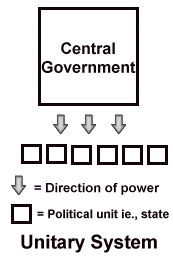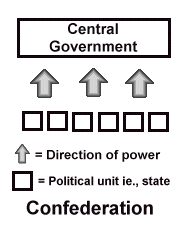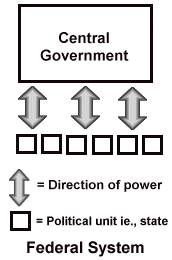


Lesson Plan:
Foundations of American GovernmentDate:
Objectives: The students will
I. identify reasons why Americans need to have government.
II. describe early efforts at American government.
III. compare American government with other forms of government from history and
current events.
Curriculum Connections: The following core learning
goals are related to this lesson:
1.02 Define the purposes of government. (Goal I PS I A 1) (SFS 2.2)
C. Comparative Types of Government
1.03 Describe differences among structures of governments: confederation, federal,
unitary. (Goal 2 PNW 2A I b)
D. Political Systems
1.04 Identify and describe various political systems: authoritarian, types of democracy
(Goal 2 PNW 2A I a)
1.05 Compare and contrast the advantages and disadvantages of each system of government
using the following criteria: a. limited/unlimited b. selection of leaders c. individual
rights d. consent of the governed e. mechanisms for change (Goal I PS I A 2a; I A 2d)
Unit II: Foundations of American Government
A. Historic Background
2.01 Trace and analyze the English background of American government. (Goal 1 PS I A 1)
*2.02 Identify and analyze Magna Carta, Mayflower Compact, and Declaration of
independence. (Goal I PS IA la)
2.03 Gather, manage, and convey information using a variety of skills, strategies,
resources, and technologies. (SFS 3.2)
B. Creation of the Articles of Confederation
2.04 Identify and analyze the nation's first plan of government. (Goal I PS I A 1)
2.05 Identify weaknesses of the Articles of Confederation. (Goal I PS I.A. 1)
2.06 Analyze why the Articles of Confederation failed. (Goal I PS I A 1)
Warm Up Activity (Anticipatory Set): Vocabulary (Based on Chapter 2 in American
Civics)
Section 1: Why Americans Have Government
Government
Absolute Monarchs
Dictatorship
Totalitarian Government
Democracy
Direct democracy
Representative Democracy/Republic
American Government
Laws
Constitutions
Section 2: Our First American Government
Declaration of Independence
Human Rights
Articles of Confederation
Confederation
Section 3: Writing And Approving the Constitution
Delegates
Constitutional Convention
Constitution of the United States
Magna Carta
Parliament
Bicameral
Compromise
Legislature
Great Compromise
Ratification
Federalists
Anti-Federalists
| Definitions to these terms are
available for use in review activities. A review activity called I Have.../Who Has... is described on this page with printable definitions formatted for the activity. |
Main Activity (Instructional Input): Forms of Government
A) Choose 5 or 6 terms from section one on various forms of government.
B) Assign each term to a group of three or four students. Have the groups develop a short 30-second skit that illustrates the meaning of the term that was assigned to them.
C) Instruct the groups that each person in the group must have at least one line in the skit. The script must be handwritten on paper or word processed on computer. The script will be evaluated for a grade.
Variation: Instruct the groups not to share the term they were assigned with any of the other groups. Once the skit has been acted out, have class members submit in writing on a piece of scrap paper (or in quiz format) which term they think has been acted out. Have the group that did the acting take guesses from the "audience" until the correct term has been discovered.
More variations: Have higher-level groups act out the meaning of the term using a "charades" format. Assign multiple terms to each group so that each person must act out at least one term.
Even more variations: Have students use the board or overhead to display a "pictionary" presentation on one or more terms. Groups can discuss how they will approach the term when it is their turn to draw. the class can be the "guesser." One team member will have to be the judge of who guessed the term first. Then it becomes that group's turn to draw. A modified game board can be used to declare a "winner.
Examples (Modeling): Developing a Diagram
A) Assign the following types of government to groups of three or four. Have students use traditional media such as posterboard, crayons, markers, and scrap magazines to develop a diagram that illustrates the type of government they were assigned.
B) The following examples have been provided:
Types of Governments
| Unitary | Confederation | Federal |
| Definition: One central government controls weaker states. Power is not shared between states, counties, or provinces. | Definition: A weak or loose organization of states agrees to follow a powerful central government. nations can choose to follow or not follow the lead of the weak central government. | Power is shared by a powerful central government and states or provinces that are given considerable self-rule, usually through their own legislatures. |
| Examples: China, United Kingdom (although Scotland has been granted self-rule). | The Commonwealth of Independent States (CIS), formerly known as the Soviet Union. Also, Switzerland's canton system and the Confederate States of America (1861-1865) | The United States, Australia, the Federal Republic of Germany. |
|
|
 |
Check For Understanding: Analyzing a Political/Historical Cartoon
A) Have students visit the NHHS Web project page entitled "The Great Compromise".
B) Have them view the political cartoon at the bottom.
C) Students should write a one paragraph response to these questions:
1) How is the Great Compromise a true compromise?
2) Describe an alternative government for the United States has the Great Compromise fallen through?
3) How do you think American history would have developed had the Great Compromise not been a success?
Guided Practice: Social Studies Skills: Page 33 American Civics
Learning From Pictures
A) After students have reviewed this skills-builder, have cooperative groups of 3 or 4
students use the Internet to arrive at the Library
of Congress' American Memory Collection of Exhibits at http://www.loc.gov/exhibits/ (or you can choose an
exhibit for your students to save time). A suggested collection for this unit might be Religion and the Founding of the Republic
at
http://lcweb.loc.gov/exhibits/religion/
B) Choose or have them choose an image to analyze. Have them review pointers 1-4 on page 33 and apply it to the image they chose or were assigned. Students should write out a one-two sentence description for each main idea.
C) Instruct students to present their reactions to the class. Students should share the address of their image so all students can view the image as they discuss and present their findings.
Homework (Independent Practice): Forms of Government in the News
A) Have students locate an article from newspaper or internet that illustrates a form of government.
B) Students should summarize the article and state its relationship to the forms of
government in the vocabulary list.
Wrap-Up Activity (Closure): The Ideals of American Government
A) Have the students brainstorm a list of ideals that Americans hold dear regarding
their government.
B) Then have the students develop a report card grade for each ideal. Students must base
the grades they give on at least one statement of fact.
C) Discuss how well American government has done both in the past and in the present in
terms of living up to the ideals of the Declaration of Independence and the Constitution.
Evaluation: The lesson will be evaluated by:
I. the accuracy of student's written responses;
II. student's scores on future tests and quizzes.
George Cassutto's Cyberlearning World
[Lesson Plan of the Day] [Cassutto Memorial] [About the Author] [Search] [Civics Lesson Plans]
| Exam JK0-701 certification material, mcitp server administrator practice test dumps book and 70-291 study guide are our most demanding training courses. We also suggest cisco ccnp dumps and 642-359 certification material. |